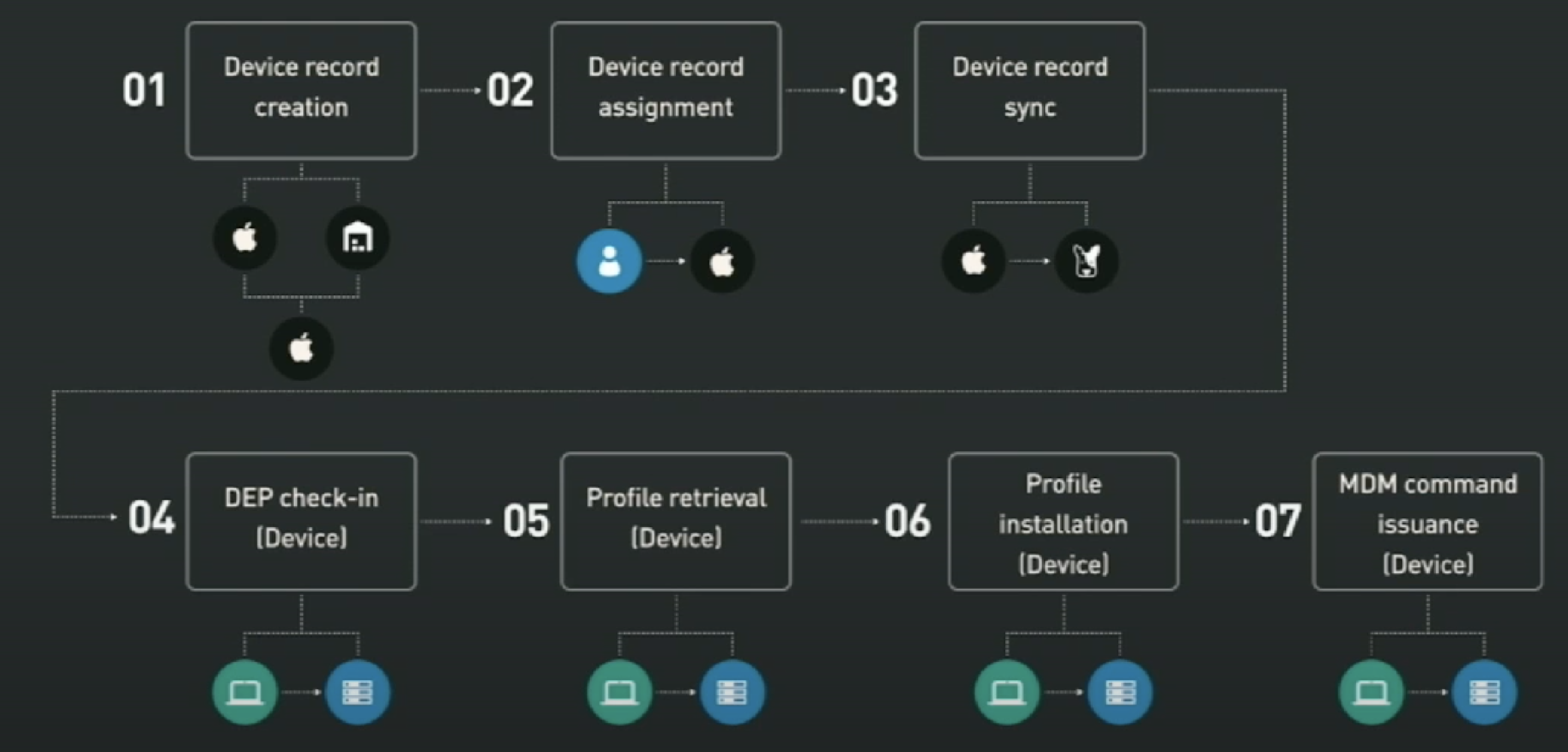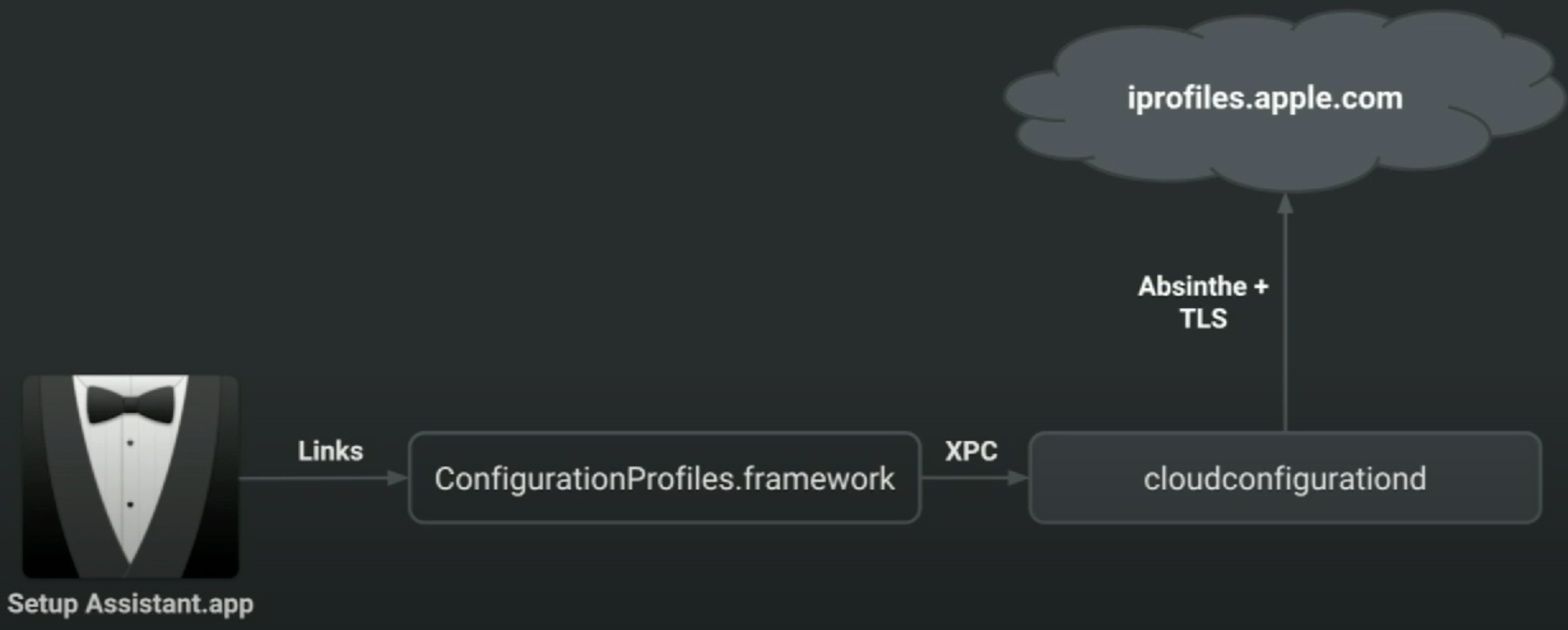| .. | ||
| enrolling-devices-in-other-organisations.md | ||
| README.md | ||
MacOS MDM
MacOS MDM
Support HackTricks and get benefits!
Do you work in a cybersecurity company? Do you want to see your company advertised in HackTricks? or do you want to have access the latest version of the PEASS or download HackTricks in PDF? Check the SUBSCRIPTION PLANS!
Discover The PEASS Family, our collection of exclusive NFTs
Get the official PEASS & HackTricks swag
Join the 💬 Discord group or the telegram group or follow me on Twitter 🐦@carlospolopm.
Share your hacking tricks submitting PRs to the hacktricks github repo.
Basics
What is MDM (Mobile Device Management)?
Mobile Device Management (MDM) is a technology commonly used to administer end-user computing devices such as mobile phones, laptops, desktops and tablets. In the case of Apple platforms like iOS, macOS and tvOS, it refers to a specific set of features, APIs and techniques used by administrators to manage these devices. Management of devices via MDM requires a compatible commercial or open-source MDM server that implements support for the MDM Protocol.
- A way to achieve centralized device management
- Requires an MDM server which implements support for the MDM protocol
- MDM server can send MDM commands, such as remote wipe or “install this config”
Basics What is DEP (Device Enrolment Program)?
The Device Enrollment Program (DEP) is a service offered by Apple that simplifies Mobile Device Management (MDM) enrollment by offering zero-touch configuration of iOS, macOS, and tvOS devices. Unlike more traditional deployment methods, which require the end-user or administrator to take action to configure a device, or manually enroll with an MDM server, DEP aims to bootstrap this process, allowing the user to unbox a new Apple device and have it configured for use in the organization almost immediately.
Administrators can leverage DEP to automatically enroll devices in their organization’s MDM server. Once a device is enrolled, in many cases it is treated as a “trusted” device owned by the organization, and could receive any number of certificates, applications, WiFi passwords, VPN configurations and so on.
- Allows a device to automatically enroll in pre-configured MDM server the first time it’s powered on
- Most useful when the device is brand new
- Can also be useful for reprovisioning workflows (wiped with fresh install of the OS)
{% hint style="danger" %} Unfortunately, if an organization has not taken additional steps to protect their MDM enrollment, a simplified end-user enrollment process through DEP can also mean a simplified process for attackers to enroll a device of their choosing in the organization’s MDM server, assuming the "identity" of a corporate device. {% endhint %}
Basics What is SCEP (Simple Certificate Enrolment Protocol)?
- A relatively old protocol, created before TLS and HTTPS were widespread.
- Gives clients a standardized way of sending a Certificate Signing Request (CSR) for the purpose of being granted a certificate. The client will ask the server to give him a signed certificate.
What are Configuration Profiles (aka mobileconfigs)?
- Apple’s official way of setting/enforcing system configuration.
- File format that can contain multiple payloads.
- Based on property lists (the XML kind).
- “can be signed and encrypted to validate their origin, ensure their integrity, and protect their contents.” Basics — Page 70, iOS Security Guide, January 2018.
Protocols
MDM
- Combination of APNs (Apple servers) + RESTful API (MDM vendor servers)
- Communication occurs between a device and a server associated with a device management product
- Commands delivered from the MDM to the device in plist-encoded dictionaries
- All over HTTPS. MDM servers can be (and are usually) pinned.
- Apple grants the MDM vendor an APNs certificate for authentication
DEP
- 3 APIs: 1 for resellers, 1 for MDM vendors, 1 for device identity (undocumented):
- The so-called DEP "cloud service" API. This is used by MDM servers to associate DEP profiles with specific devices.
- The DEP API used by Apple Authorized Resellers to enroll devices, check enrollment status, and check transaction status.
- The undocumented private DEP API. This is used by Apple Devices to request their DEP profile. On macOS, the
cloudconfigurationdbinary is responsible for communicating over this API.
- More modern and JSON based (vs. plist)
- Apple grants an OAuth token to the MDM vendor
DEP "cloud service" API
- RESTful
- sync device records from Apple to the MDM server
- sync “DEP profiles” to Apple from the MDM server (delivered by Apple to the device later on)
- A DEP “profile” contains:
- MDM vendor server URL
- Additional trusted certificates for server URL (optional pinning)
- Extra settings (e.g. which screens to skip in Setup Assistant)
Steps for enrolment and management
- Device record creation (Reseller, Apple): The record for the new device is created
- Device record assignment (Customer): The device is assigned to a MDM server
- Device record sync (MDM vendor): MDM sync the device records and push the DEP profiles to Apple
- DEP check-in (Device): Device gets his DEP profile
- Profile retrieval (Device)
- Profile installation (Device) a. incl. MDM, SCEP and root CA payloads
- MDM command issuance (Device)
The file /Library/Developer/CommandLineTools/SDKs/MacOSX10.15.sdk/System/Library/PrivateFrameworks/ConfigurationProfiles.framework/ConfigurationProfiles.tbd exports functions that can be considered high-level "steps" of the enrolment process.
Step 4: DEP check-in - Getting the Activation Record
This part of the process occurs when a user boots a Mac for the first time (or after a complete wipe)
or when executing sudo profiles show -type enrollment
- Determine whether device is DEP enabled
- Activation Record is the internal name for DEP “profile”
- Begins as soon as the device is connected to Internet
- Driven by
CPFetchActivationRecord - Implemented by
cloudconfigurationdvia XPC. The "Setup Assistant" (when the device is firstly booted) or theprofilescommand will contact this daemon to retrieve the activation record.- LaunchDaemon (always runs as root)
It follows a few steps to get the Activation Record performed by MCTeslaConfigurationFetcher. This process uses an encryption called Absinthe
- Retrieve certificate
- Initialize state from certificate (
NACInit)- Uses various device-specific data (i.e. Serial Number via
IOKit)
- Uses various device-specific data (i.e. Serial Number via
- Retrieve session key
- Establish the session (
NACKeyEstablishment) - Make the request
- POST to https://iprofiles.apple.com/macProfile sending the data
{ "action": "RequestProfileConfiguration", "sn": "" } - The JSON payload is encrypted using Absinthe (
NACSign) - All requests over HTTPs, built-in root certificates are used
- POST to https://iprofiles.apple.com/macProfile sending the data
The response is a JSON dictionary with some important data like:
- url: URL of the MDM vendor host for the activation profile
- anchor-certs: Array of DER certificates used as trusted anchors
Step 5: Profile Retrieval
- Request sent to url provided in DEP profile.
- Anchor certificates are used to evaluate trust if provided.
- Reminder: the anchor_certs property of the DEP profile
- Request is a simple .plist with device identification
- Examples: UDID, OS version.
- CMS-signed, DER-encoded
- Signed using the device identity certificate (from APNS)
- Certificate chain includes expired Apple iPhone Device CA
Step 6: Profile Installation
- Once retrieved, profile is stored on the system
- This step begins automatically (if in setup assistant)
- Driven by
CPInstallActivationProfile - Implemented by mdmclient over XPC
- LaunchDaemon (as root) or LaunchAgent (as user), depending on context
- Configuration profiles have multiple payloads to install
- Framework has a plugin-based architecture for installing profiles
- Each payload type is associated with a plugin
- Can be XPC (in framework) or classic Cocoa (in ManagedClient.app)
- Example:
- Certificate Payloads use CertificateService.xpc
Typically, activation profile provided by an MDM vendor will include the following payloads:
com.apple.mdm: to enroll the device in MDMcom.apple.security.scep: to securely provide a client certificate to the device.com.apple.security.pem: to install trusted CA certificates to the device’s System Keychain.- Installing the MDM payload equivalent to MDM check-in in the documentation
- Payload contains key properties:
- MDM Check-In URL (
CheckInURL) - MDM Command Polling URL (
ServerURL) + APNs topic to trigger it - To install MDM payload, request is sent to
CheckInURL - Implemented in
mdmclient - MDM payload can depend on other payloads
- Allows requests to be pinned to specific certificates:
- Property:
CheckInURLPinningCertificateUUIDs - Property:
ServerURLPinningCertificateUUIDs - Delivered via PEM payload
- Property:
- Allows device to be attributed with an identity certificate:
- Property: IdentityCertificateUUID
- Delivered via SCEP payload
Step 7: Listening for MDM commands
- After MDM check-in is complete, vendor can issue push notifications using APNs
- Upon receipt, handled by
mdmclient - To poll for MDM commands, request is sent to ServerURL
- Makes use of previously installed MDM payload:
ServerURLPinningCertificateUUIDsfor pinning requestIdentityCertificateUUIDfor TLS client certificate
Attacks
Enrolling Devices in Other Organisations
As previously commented, in order to try to enrol a device into an organization only a Serial Number belonging to that Organization is needed. Once the device is enrolled, several organizations will install sensitive data on the new device: certificates, applications, WiFi passwords, VPN configurations and so on.
Therefore, this could be a dangerous entrypoint for attackers if the enrolment process isn't correctly protected:
{% content-ref url="enrolling-devices-in-other-organisations.md" %} enrolling-devices-in-other-organisations.md {% endcontent-ref %}
References
Support HackTricks and get benefits!
Do you work in a cybersecurity company? Do you want to see your company advertised in HackTricks? or do you want to have access the latest version of the PEASS or download HackTricks in PDF? Check the SUBSCRIPTION PLANS!
Discover The PEASS Family, our collection of exclusive NFTs
Get the official PEASS & HackTricks swag
Join the 💬 Discord group or the telegram group or follow me on Twitter 🐦@carlospolopm.
Share your hacking tricks submitting PRs to the hacktricks github repo.




